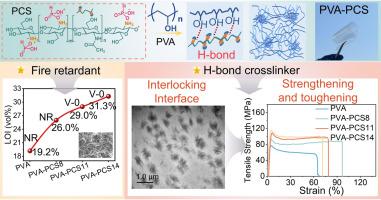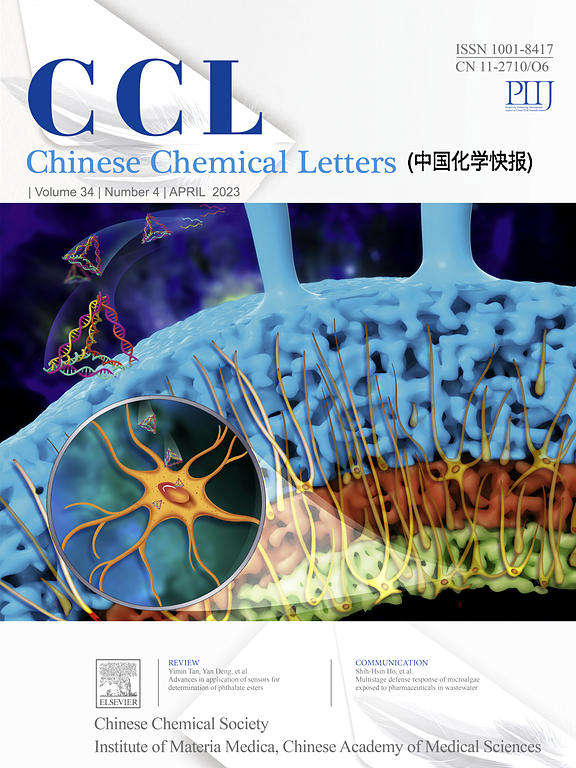H3PO3-protonated chitosan enabling flame-retardant and antibacterial PVA composite films with high strength and toughness through multiple H-bonds and interlocking interfaces
IF 8.9
1区 化学
Q1 CHEMISTRY, MULTIDISCIPLINARY
引用次数: 0
Abstract
Developing polymer materials combining high strength, toughness, multifunctionality, and environmental sustainability remains a major challenge. Herein, high-performance PVA-PCSx composite films were successfully fabricated by incorporating H3PO3-protonated chitosan (PCS) into the PVA matrix as both a bio-based multi-hydrogen-bonding crosslinking agent and a macromolecular flame retardant. Specifically, a comprehensive investigation was conducted on the hydrogen bonding interactions, microstructure, mechanical properties, antibacterial performance, and flame retardancy of the PVA-PCSx films. Strong hydrogen bonds between PCS and PVA enabled excellent compatibility and formed a unique mechanical interlocking interface architecture. This further resulted in superior transparency and synchronous reinforcement and toughening effects in the composites films. Compared with pure PVA, the PVA-PCSx films showed a 23 %-51 % increase in tensile strength and an 80 %-108 % improvement in fracture toughness. Moreover, PVA-PCSx films exhibited superior fire safety performance, achieving an LOI value of 31.3 %, attaining UL-94 V-0 rating, and reducing the heat release rate by up to 73.1 %. Additionally, PVA-PCSx films demonstrated 99.99 % antibacterial efficacy against both Escherichia coli and Staphylococcus aureus. Collectively, this study presents a simple yet effective strategy for fabricating high-strength, high-toughness, multifunctional composites using biopolysaccharides as additives.

h3po3 -质子化壳聚糖通过多个氢键和互锁界面,使阻燃和抗菌PVA复合膜具有高强度和韧性
开发高强度、高韧性、多功能和环境可持续性的高分子材料仍然是一个重大挑战。本文将h3po3 -质子化壳聚糖(PCS)作为生物基多氢键交联剂和高分子阻燃剂加入PVA基体中,成功制备了高性能PVA- pcsx复合薄膜。具体而言,对PVA-PCSx薄膜的氢键相互作用、微观结构、力学性能、抗菌性能和阻燃性能进行了全面的研究。PCS和PVA之间的强氢键使其具有良好的兼容性,形成了独特的机械联锁界面结构。这进一步导致了优异的透明度和同步增强和增韧复合膜的效果。与纯PVA相比,PVA- pcsx薄膜的拉伸强度提高了23 % ~ 51 %,断裂韧性提高了80 % ~ 108 %。此外,PVA-PCSx薄膜表现出优异的消防安全性能,LOI值达到31.3 %,UL-94 V-0等级,放热率降低高达73.1 %。此外,PVA-PCSx膜对大肠杆菌和金黄色葡萄球菌的抗菌效果均达到99.99 %。总的来说,本研究提出了一种简单而有效的方法来制造高强度、高韧性、多功能的复合材料,使用生物多糖作为添加剂。
本文章由计算机程序翻译,如有差异,请以英文原文为准。
求助全文
约1分钟内获得全文
求助全文
来源期刊

Chinese Chemical Letters
化学-化学综合
CiteScore
14.10
自引率
15.40%
发文量
8969
审稿时长
1.6 months
期刊介绍:
Chinese Chemical Letters (CCL) (ISSN 1001-8417) was founded in July 1990. The journal publishes preliminary accounts in the whole field of chemistry, including inorganic chemistry, organic chemistry, analytical chemistry, physical chemistry, polymer chemistry, applied chemistry, etc.Chinese Chemical Letters does not accept articles previously published or scheduled to be published. To verify originality, your article may be checked by the originality detection service CrossCheck.
 求助内容:
求助内容: 应助结果提醒方式:
应助结果提醒方式:


